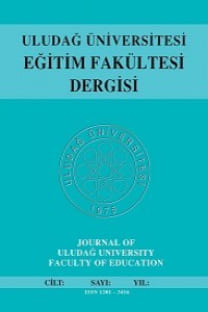Eugène Ionesco'nun İki Farklı Son Perdeli Oyununun Çevirilerinin İncelenmesi: Amédée ya da Ondan Nasıl Kurtulmalı
Yazınsal çevirinin sorunları üzerine günümüzde çok sayıda araştırmayapılmış olsa da, bu, tiyatro çevirisi için geçerli değildir. Bu alandaki çalışmaların veeleştirilerin azlığından dolayı, tiyatro çevirilerinde halen üzerinde durulacak bir çoksorun mevcuttur. Tiyatro metninin seyirci karşısına çıkacak bir sahne metni olarakçevrilmemesinin yanı sıra, hedef topluma farklı sözcelemlerin ve kültürel ifadelerinaktarımının ikinci planda kalması karşımıza çıkan sorunlardandır. Bu duruma farklıbir bakış açısı getirmek amacıyla, XX. yüzyıla yeni bir tiyatro akımıyla damgasınıvuran, trajikomik bir düzlemde ölüm, yalnızlık ve iletişimsizlik gibi konuları elealan uyumsuz tiyatronun öncülerinden Eugène Ionesconun Amédée Ya Da OndanNasıl Kurtulmalı oyununu seçtik. Çünkü, Ionesco yazdığı tiyatro metinlerininsadece diyaloglardan oluşmadığını aynı zamanda sahne düzeni ve görsel unsurlarında ön planda olduğunu belirttiğinden, söz konusu oyun için iki farklı son yazmıştır.Çalışmamızda, oyunun üçüncü perdesinin farklı yıllarda ve farklı çevirmenlertarafından Türkçeye ve İngilizceye çevirileri üzerine çeviri incelemesi yaparaktiyatro çevirisi alanına katkı sağlamayı amaçlamaktayız.
The Analysis of Translations of Eugène Ionesco s Theatre Play Which Has Two Different Ends: Amédée or How To Get Rid of It
Although there are many researches on the problems of literary translationtoday, the same thing is not valid for theatre translation. Due to limited number ofstudies and criticisms in this area, there are many issues to be considered in theatretranslation. That the theatre texts are not translated as texts to be staged in front of anaudience and that the different words and cultural expressions to be translated intothe target society are of secondary importance are problems faced. In order to bringa different perspective to this issue, we chose Eugène Ionesco s "Amédée or HowTo Get Rid of It" play which is about death, loneliness and lack of communicationon a tragicomic platform, which marked its label on the XX. Century with a newtheatre trend. Because Ionesco highlights that his plays do not include just dialoguesbut stage set and visual elements, he wrote two different ends for his play. We aimto contribute to the area of theatre translation by analyzing the Turkish and Englishtranslations of the third stage of the play translated in different years and by differenttranslators.
___
- Aksoy, N. B. 2002. Geçmişten Günümüze Yazın Çevirisi. Ankara: İmge Kitabevi.
- Artaud, A. 1964. Le Théâtre et son double,.Paris: Gallimard.
- Bensimon, P. 1999. Traduire le dialogue, Traduire les textes de théâtre. France: Presses De La Sorbonne Nouvelle.
- Déprats, J. M. 2002. Shakespeare - Tragédies I. Paris: Gallimard.
- Göktürk, A. 1986. Çeviri: Dillerin Dili. İstanbul: Çağdaş.
- Hubert, M. C. 1990. Eugène Ionesco. France: Seuil.
- Ionesco, E. 1966. Notes et contre-notes. Paris: Gallimard.
- Ionesco, E. 1991. Théâtre Complet. Paris: Gallimard.
- Ionesco, E. 1996. Amédée Ya Da Ondan Nasıl Kurtulmalı (çev: Hasan Anamur). İstanbul: Mitos Boyut Yayınları.
- Kıran, M., ve Uzundemir. Ö. 1995. Amédée Ya Da Ondan Nasıl Kurtulmalı. In Absürd Tiyatro. Ankara: İmge Kitabevi.
- Mirza, G. 1991. Amédée Ya da Nasıl Başından Atarsın Onu. İstanbul: Düzlem Yayınları.
- Pavis, P. 1999. Sahneleme-Kültürler Kavşağında Tiyatro (çev: Sibel Kamber). Ankara: Dost Kitabevi.
- Pavis, P. 2009. Dictionnaire du Théâtre. Paris: Armand Colin.
- Seleskovitch, D., and Lederer, M. 2001. Interpreter pour traduire. Paris: Didier Erudition.
- Watson, D. 1965. Amédée Or How To Get Rid Of It. In Absurd Drama. England: Penguins Books.
- Başlangıç: 1986
- Yayıncı: Bursa Uludağ Üniversitesi Eğitim Fakültesi
Sayıdaki Diğer Makaleler
Türk Çeviri Tarihimizde Mütercim Ahmed Rasim: Çeviri Odaklı Bir İnceleme İçin Ön Çalışma Notları
Denis Diderot'nun La Religieuse (Rahibe) Adlı Romanında Özgürlük Direnci
Cannibale'de 1931 Uluslar Arası Paris Sömürge Sergisi
François Mauriac'ın Roman Evreninden Karmaşık Bir Karakter: Yılan Düğümü ndeki Louis
Nurhayat ATAN, Fatma KAZANOĞLU, Havva ÖZÇELEBİ
Zola'nın Gerçek ve Güntekin'in Yeşil Gece Adlı Romanlarında Dinin Çıkarlara Alet Edilmesi
